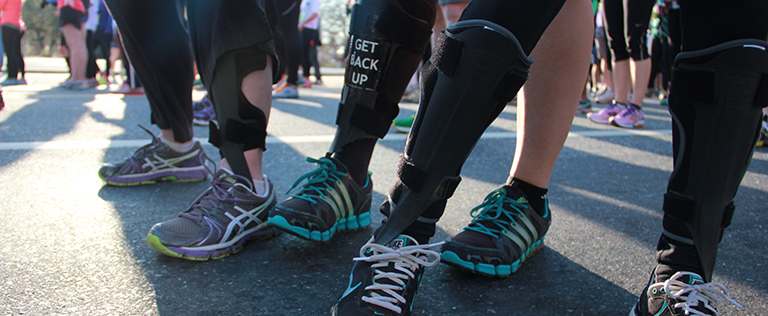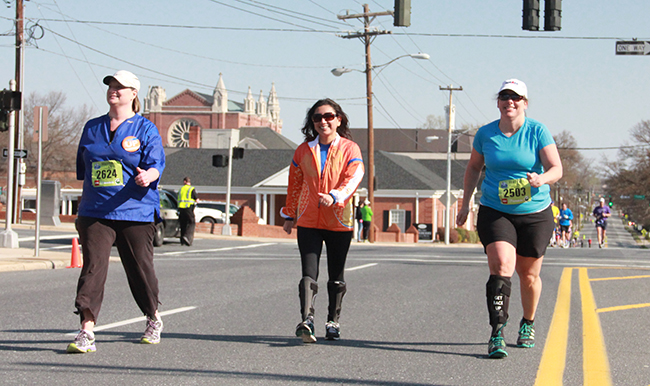
Getting diagnosed with a condition such as Multiple Sclerosis or Charcot Marie Tooth is a life-changing moment in countless ways. But many patients accept the onset of a commonly associated symptom known as “Foot Drop” as a part of their newfound life, rarely learning that the condition even has a name. In fact, according to a 2016 survey by ORC International, only 17% of people knew what Foot Drop was. Why does this little-known condition create so much difficulty yet garner so little awareness? Let’s dig into the debilitating phenomenon known as Foot Drop.
What Exactly is Foot Drop?
Foot drop is defined as the inability to raise the front part of the foot or ankle due to weakness or paralysis of the muscles that lift the foot. It can affect both feet, or it can be isolated to one specific foot, often depending on the underlying condition that caused Foot Drop.
Because people with Foot Drop aren’t able to lift their foot fully, they may scuff their toes along the ground or lift their knees up high to avoid scuffing, stumbling or dragging the toes while walking. This extra effort can often result in tripping or falling—a reality that can lead to the patient simply thinking they are clumsy or careless, or worse, lead to more severe injuries to the patient from the fall.
Other indications of Foot Drop include a “slapping” of the foot with each step; an inability to point the toes upward or move the ankle from side to side; and pain, weakness or numbness in the foot or toes.
What Causes Foot Drop?
There are various causes of Foot Drop, but they all involve muscles and/or nerves in the body. These are just some of the diagnoses that may result in the condition called Foot Drop:
- Stroke
- Multiple Sclerosis
- Post-Polio Syndrome
- Muscular Dystrophy
- Spinal Cord Injuries
- Traumatic Brain Injuries
- Guillian-Barre Syndrome
- Charcot-Marie-Tooth
- Myelomeningocele
- Neuropathy
- Cerebral Palsy
- Spina Bifida
Anyone can develop it, but Foot Drop itself is not a disease. Rather, it is a symptom of what can be a temporary or permanent problem—typically one of the neurological disorders or injuries mentioned above.
For those with a neurological disorder, Foot Drop has a higher chance of being a lifelong symptom. If Foot Drop were developed from an accident or spinal cord injury, it could be temporary, but that isn’t guaranteed.

How Does Foot Drop Affect People Who Have It?
The effects of this condition become apparent as people try to resume their everyday lives. Foot Drop makes it difficult (if not impossible) for individuals to walk properly or participate in activities that require physical movement (biking, running, etc.).
The inability to properly lift the foot can even make it hard to do the simplest of tasks, like getting dressed in the morning and putting on shoes. For some, it means spending some time in a wheelchair or using a walker or crutches.
How Can Foot Drop Be Treated?
Treatment is dependent on what caused Foot Drop in the first place. For temporary cases, there are exercises that an individual can do to help regain control over their foot. These exercises include foot movements like foot circles and rolling up onto the toes. Individuals with Foot Drop can always consult with a physiotherapist to brainstorm exercises that work best with their own level of impairment.
There are other, less common forms of treatment like electrical stimulation that sends an electrical impulse to the nerves of the foot while walking. For more permanent cases of Foot Drop, some find success with surgery.
However, the most common treatment for Foot Drop is an ankle-foot orthosis (AFO). An AFO is a brace that slips into the shoe and stabilizes the foot and ankle to regulate the process of taking a step. Due to the various causes of Foot Drop and the diverse group of people who can develop it, there are multiple types of braces that are made for different levels of support.
Allard USA offers several braces for Foot Drop patients, all dependent on how severe their case is: the Ypsilon® provides mild stability, the ToeOFF® moderate stability and the BlueROCKER® maximum stability.
With the right brace, someone living with Foot Drop often is able to return to a lifestyle almost identical to the one prior to their diagnosis. Some TeamUP co-captains even cultivated a more active, more athletic lifestyle for themselves after they found their perfect AFO.
To find the perfect brace, an individual with Foot Drop should see an orthotist to have one ordered and adjusted to fit. Each foot (and the person its attached to) is different, so it’s important to understand that this process can require patience and determination.
Facing a life impeded by Foot Drop might seem like a hopeless effort. But there are many affected by the condition living their lives on their own terms, showing that it’s always possible to Get Back Up Today!

Recent Comments